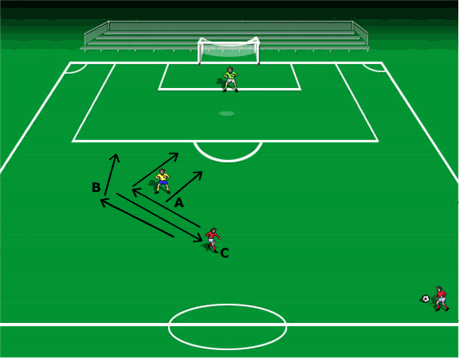Individual Striker Movements Off the Shoulder Part 1
/This is part 1 of 4 on our Individual Striker Movements Off the Shoulder Series.
We are excited to provide you with one of our popular soccer coaching ebooks today... Learn the "Look and Think" Model Of Player Development which will get ever player on your team to think and act several steps ahead of play and think fast! Click here to download the popular Coaching Soccer Awareness E-Book FREE!
The movement of the striker, the three ideas, working opposites on the first two.
- Short to go long, (opposite run)
- Long to come short, opposite run)
- Off the shoulder of the defender.
Player A makes a diagonal run away to invite a ball “off / over the shoulder” of the marking defender.
On 1) the striker takes the defender towards the ball to create space behind, either for themselves or a team mate.
On 2) the striker takes the defender away to create space in front and short to check back into for themselves or a team mate.
On 3) Here the striker runs away and invites a ball off or over the shoulder of the defender, in this situation the striker is off the right shoulder of the defender. The ball may be delivered off (outside) the right shoulder of the defender so it goes wider, or (inside) the left shoulder of the defender so the striker cuts inside the defender either in front or behind them, or moves towards the ball and receives to feet.
“Off The Shoulder” Has Three Further Movements To Consider
Carrying this idea on the striker in this position has three ideas for moves each of which help the striker to end up in a position where they are facing FORWARD:
- Away from the defender then back across the defender either in front of them or behind them for the delivery inside the defender. If the defender checks away with the striker, then the striker checks back inside to their right; the defenders left (especially as the defender in this case plants their right foot down and are slightly off balance going to their right; the strikers left) always facing forward. If not checked by the defender then the striker attacks behind the defender for the diagonal pass inside the defenders start position.
- Moving and staying off the shoulder for the delivery outside the defender to attack, the player on the ball plays a diagonal pass over the shoulder of the defender into the path of the striker facing forward. The striker by making this move opens up the angle for the pass and gets in line still with the defender so as not to be offside but again facing forward, ready to attack the pass in front of them.
- Going short to the ball to receive the delivery to feet after first moving not towards but away from the defending player and the ball, and ending up facing forward.
- In this case the defender “should” drop off to cover themselves so the striker can’t make a run behind them, but this is the cue for the striker to check to the ball from a wider angle and more open body stance so they receive the ball at their feet; but facing forward with space to run at the defender; not with their back to goal and with their back to the defender. The first movement helps this space be created.
The defender starts in the same position as the striker though it isn’t shown here.
I believe this is a good way of simplifying movements by the striker in this position and giving them a framework to play from, they may develop their own variations of these three moves but it is a good planning tool to use in training so the players making the delivery at least have an idea what the striker may attempt in terms of his or her movement based on the position of the defender.



















